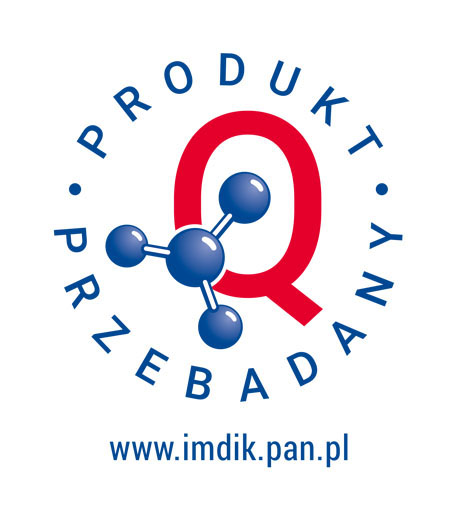Head
Michał Węgrzynowicz, PhD - phone: +48 22 608 64 05; email: This email address is being protected from spambots. You need JavaScript enabled to view it. room C-301
Research staff
Aleksandra Owczarek, PhD - phone: +48 22 608 65 21; email: This email address is being protected from spambots. You need JavaScript enabled to view it. room C-303
PhD students
Aleksandra Duchnowska, MSc - phone: +48 22 608 65 21; email: This email address is being protected from spambots. You need JavaScript enabled to view it.
Martyna Nalepa, MSc Eng - phone: +48 22 608 65 21; email: This email address is being protected from spambots. You need JavaScript enabled to view it. room C-303
Aleksandra Skweres, MSc - phone: +48 22 608 65 21; email: This email address is being protected from spambots. You need JavaScript enabled to view it. room C-303
Graduate students
Filip Suchożebski - phone: +48 22 608 65 21; email: This email address is being protected from spambots. You need JavaScript enabled to view it. room C-303
Research profile
The Laboratory was set up in 2019. The studies carried out in the Laboratory are aimed at understanding the mechanisms responsible for neuronal dysfunction and death in different neurodegenerative diseases like Huntington's disease, Parkinson's disease, Alzheimer's disease and others. We are particularly interested in the causes and consequences of protein aggregation, a phenomenon considered as a fundamental factor in neurodegeneration. We would like to understand what are the common pathways in the pathogenesis of different neurodegenerative diseases, but also what constitutes the basis for clinical and neuropathological correlates specific for individual diseases. Why, in particular disease, given protein is prone to aggregate in specific cell type and not in the other. Why defined brain regions are exceptionally sensitive to the toxicity related to aggregation of specific protein, when other brain regions are protected. Is it related to the cell-autonomous factors (like intrinsic functional or molecular properties of the cell) or to external stimuli (like interactions within cellular microenvironment or anatomical and functional connections with other brain regions). We believe that answering these questions will help to develop novel, mechanism-based therapeutic strategies against currently incurable neurodegenerative diseases.
Grants
Role of arginase 2 in the function of the striatum and in the pathogenesis of Huntington's disease
- funding: National Science Centre, Sonata Bis grant 2018/30/E/NZ1/00144
- principal investigator: Michał Węgrzynowicz, PhD
- timeline: 2019-2025
Distribution and identification of hippocampal proteins undergoing posttranslational modifications with putrescine in hypoxia
- funding: National Science Centre, Miniatura grant
- principal investigator: Aleksandra Owczarek, PhD
- timeline: 2023-2024
Importance of polyamine metabolism compartmentation in hippocampus for differential sensitivity of CA1-CA3 regions to excitotoxicity; role of mitochondrial calcium homeostasis
- funding: Internal Research Fund, MMRI PAS, no. FBW-024
- principal investigator: Aleksandra Kaczyńska, MSc
- timeline: 2023-2024
Utilization of novel probe TvS-Put for identification of the proteins undergoing posttranslational modifications with putrescine in hippocampal region CA2 in mouse
- funding: Internal Research Fund, MMRI PAS, no. FBW-019
- principal investigator: Michał Węgrzynowicz, PhD
- timeline: 2021-2023
Domestic collaboration
- prof. Barbara Zabłocka, dr. Małgorzata Beręsewicz-Haller, Molecular Biology Unit, Mossakowski Medical Research Institute, Polish Academy of Sciences, Warsaw
- dr. Remigiusz Serwa, Proteomics Core Facility, International Institute of Molecular Mechanisms and Machines, Polish Academy of Sciences, Warsaw
- dr. Emilia Samborowska, Mass Spectrometry Laboratory, Institute of Biochemistry and Biophysics, Polish Academy of Sciences, Warsaw
- prof. Agata Adamczyk, dr. Anna Wilkaniec, Department of Cellular Signalling, Mossakowski Medical Research Institute, Polish Academy of Sciences, Warsaw
- dr. Katarzyna Winiarska, Department of Metabolic Regulation, Faculty of Biology, University of Warsaw
- prof. Magdalena Zielińska, Department of Neurotoxicology, Mossakowski Medical Research Institute, Polish Academy of Sciences, Warsaw
- dr. Beata Toczyłowska, Laboratory of Diagnosis and Therapy Support of Metabolic Diseases, Nalecz Institute of Biocybernetics and Biomedical Engineering, Polish Academy of Sciences, Warsaw
- dr. Karolina Szczepanowska, Laboratory of Metabolic Quality Control, International Institute of Molecular Mechanisms and Machines, Polish Academy of Sciences, Warsaw
- dr. Małgorzata Frontczak-Baniewicz, dr. Magdalena Gewartowska, Laboratory of Electron Microscopy, Mossakowski Medical Research Institute, Polish Academy of Sciences, Warsaw
- dr. Grzegorz Kreiner, Department of Brain Biochemistry, Maj Institute of Pharmacology, Polish Academy of Sciences, Cracow
International collaboration
- prof. Maria Grazia Spillantini, PhD, Department of Clinical Neurosciences, University of Cambridge, UK
- dr. Giorgio Vivacqua, Faculty of Medicine and Surgery, Campus Biomedico University of Roma, Italy
- prof. Aaron Bowman, School of Health Sciences, Purdue University, West Lafayette, USA
- prof. Ricardo Borges, Department of Physical Medicine and Pharmacology, Pharmacology Unit, Medical School, University of La Laguna, Spain
Research equipment
• Fast cooling unit for microtomes, Slee Medical MTR
• Stereomicroscope, Nikon SMZ800N
• Centrifugal vacuum concentrator, Eppendorf Concentrator 5301
Research methods
- Employing transgenic animal models to study pathology of the Central Nervous System
- Organotypic cultures of rat hippocampus
- Studies employing acute brain slices
- Precise dissection of rodent CNS tissues
- High-sensitivity histological, immunohistochemical and immunofluorescence techniques
- Modelling pathological states (excitotoxicity, hypoxia) in vitro
- Experimental regulation of selected cellular pathways in vitro using pharmacological and genetic techniques
- Isolation of subcellular fractions from animal tissues
- Qualitative and quantitative microscopic analysis
- Real-time analysis of cellular/subcellular fluctuations of calcium and nitric oxide in vitro
- Imaging and biochemical analyses of protein posttranslational modifications using novel probes
- Click chemistry
- Measurements of metabolites in animal tissues
- Enzymatic activity measurements
- Immunodetection of proteins (western blot, dot blot, filter retardation assay)
- Protein aggregation analysis (fractionation, filtration, enzymatic digestion, fluorescence probes)
- Behavioural assessment of motor and cognitive functions in mice
- Stereotactic brain surgery (injections, implantations)
- Microdialysis
Selected publications
- Pawlik M, Czarnecka AM, Kołodziej M, Skowrońska K, Węgrzynowicz M, Podgajna M, Czuczwar SJ, Albrecht J (2023) Attenuation of initial pilocarpine-induced electrographic seizures by methionine sulfoximine pretreatment tightly correlates with the reduction of extracellular taurine in the hippocampus. Epilepsia. 64(5):1390-1402
- Vivacqua G, Mason M, De Bartolo MI, Węgrzynowicz M, Calò L, Belvisi D, Suppa A, Fabbrini G, Berardelli A, Spillantini M (2023) Salivary α-Synuclein RT-QuIC Correlates with Disease Severity in de novo Parkinson's Disease. Mov Disord. 38(1):153-155
- Levin J, Sing N, Melbourne S, Morgan A, Mariner C, Spillantini MG, Wegrzynowicz M, Dalley JW, Langer S, Ryazanov S, Leonov A, Griesinger C, Schmidt F, Weckbecker D, Prager K, Matthias T, Giese A (2022) Safety, tolerability and pharmacokinetics of the oligomer modulator anle138b with exposure levels sufficient for therapeutic efficacy in a murine Parkinson model: A randomised, double-blind, placebo-controlled phase 1a trial. EBioMedicine. 80:104021
- Grzywa TM, Sosnowska A, Rydzynska Z, Lazniewski M, Plewczynski D, Klicka K, Malecka-Gieldowska M, Rodziewicz-Lurzynska A, Ciepiela O, Justyniarska M, Pomper P, Grzybowski MM, Blaszczyk R, Wegrzynowicz M, Tomaszewska A, Basak G, Golab J, Nowis D (2021) Potent but transient immunosuppression of T-cells is a general feature of CD71+ erythroid cells. Commun Biol. 4(1):1384
- Caló L, Hidari E, Wegrzynowicz M, Dalley JW, Schneider BL, Podgajna M, Anichtchik O, Carlson E, Klenerman D, Spillantini MG (2021) CSPα reduces aggregates and rescues striatal dopamine release in α-synuclein transgenic mice. Brain. 144(6):1661-1669
- Migdalska‐Richards A*, Wegrzynowicz M*, Harrison IF, Verona G, Bellotti V, Spillantini MG, Schapira AHV (2020) L444P Gba1 mutation increases formation and spread of α-synuclein deposits in mice injected with mouse α-synuclein pre-formed fibrils. PLoS One. 15(8):e0238075
Prior publications of the Laboratory members:
- Owczarek A, Gieczewska KB, Jarzyna R, Frydzinska Z, Winiarska K (2021) Transcription Factor ChREBP Mediates High Glucose-Evoked Increase in HIF-1α Content in Epithelial Cells of Renal Proximal Tubules. Int J Mol Sci. 22(24):13299
- Owczarek A, Gieczewska KB, Polanska M, Paterczyk B, Gruza A, Winiarska K. (2021) Melatonin Lowers HIF-1α Content in Human Proximal Tubular Cells (HK-2) Due to Preventing Its Deacetylation by Sirtuin 1. Front Physiol. 11:572911
- Owczarek A, Gieczewska K, Jarzyna R, Jagielski AK, Kiersztan A, Gruza A, Winiarska K (2020) Hypoxia increases the rate of renal gluconeogenesis via hypoxia-inducible factor-1-dependent activation of phosphoenolpyruvate carboxykinase expression. Biochimie. 171-172:31-37
- Wegrzynowicz M, Bar-On D, Calo' L, Anichtchik O, Iovino M, Xia J, Ryazanov S, Leonov A, Giese A, Dalley JW, Griesinger C, Ashery U, Spillantini MG (2019) Depopulation of dense α-synuclein aggregates is associated with rescue of dopamine neuron dysfunction and death in a new Parkinson's disease model. Acta Neuropathol. 138(4):575-595
- Migdalska-Richards A, Wegrzynowicz M, Rusconi R, Deangeli G, Di Monte DA, Spillantini MG, Schapira AHV (2017) The L444P Gba1 mutation enhances alpha-synuclein induced loss of nigral dopaminergic neurons in mice. Brain. 140(10):2706-2721
- Bichell TJV*, Wegrzynowicz M*, Tipps KG, Bradley EM, Uhouse MA, Bryan M, Horning K, Fisher N, Dudek K, Halbesma T, Umashanker P, Stubbs AD, Holt HK, Kwakye GF, Tidball AM, Colbran RJ, Aschner M, Neely MD, Di Pardo A, Maglione V, Osmand A, Bowman AB (2017) Reduced bioavailable manganese causes striatal urea cycle pathology in Huntington's disease mouse model. Biochim Biophys Acta Mol Basis Dis. 1863(6):1596-1604
- Calo L, Wegrzynowicz M, Santivañez-Perez J, Grazia Spillantini M (2016) Synaptic failure and α-synuclein. Mov Disord. 31(2):169-77
- Tozzi A, de Iure A, Bagetta V, Tantucci M, Durante V, Quiroga-Varela A, Costa C, Di Filippo M, Ghiglieri V, Latagliata EC, Wegrzynowicz M, Decressac M, Giampà C, Dalley JW, Xia J, Gardoni F, Mellone M, El-Agnaf OM, Ardah MT, Puglisi-Allegra S, Björklund A, Spillantini MG, Picconi B, Calabresi P (2016) Alpha-Synuclein Produces Early Behavioral Alterations via Striatal Cholinergic Synaptic Dysfunction by Interacting With GluN2D N-Methyl-D-Aspartate Receptor Subunit. Biol Psychiatry. 79(5):402-414
- Winiarska K, Dzik JM, Labudda M, Focht D, Sierakowski B, Owczarek A, Komorowski L, Bielecki W (2016) Melatonin nephroprotective action in Zucker diabetic fatty rats involves its inhibitory effect on NADPH oxidase. J Pineal Res. 60(1):109-117
- Wegrzynowicz M*, Bichell TJ*, Soares BD, Loth MK, McGlothan JS, Mori S, Alikhan FS, Hua K, Coughlin JM, Holt HK, Jetter CS, Pomper MG, Osmand AP, Guilarte TR, Bowman AB (2015) Novel BAC Mouse Model of Huntington's Disease with 225 CAG Repeats Exhibits an Early Widespread and Stable Degenerative Phenotype. J Huntingtons Dis. 4(1):17-36.
- Wegrzynowicz M, Holt HK, Friedman DB, Bowman AB (2012) Changes in the striatal proteome of YAC128Q mice exhibit gene-environment interactions between mutant huntingtin and manganese. J Proteome Res. 11(2):1118-3
- Williams BB, Li D, Wegrzynowicz M, Vadodaria BK, Anderson JG, Kwakye GF, Aschner M, Erikson KM, Bowman AB (2010) Disease-toxicant screen reveals a neuroprotective interaction between Huntington's disease and manganese exposure J Neurochem. 112(1):227-3






